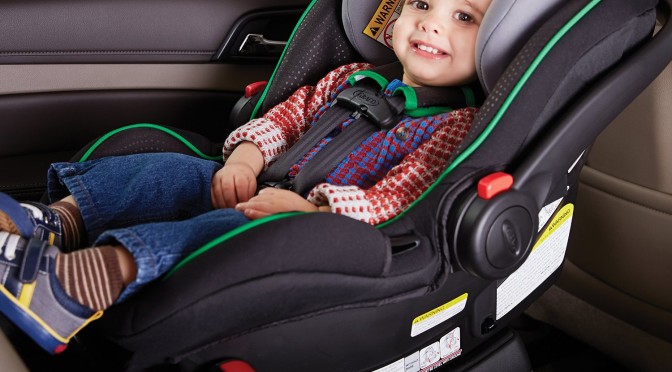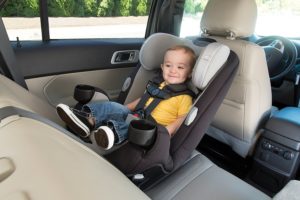
If you’ve got toddlers, you know convincing them to do just about anything (even things they want to do) can be a challenge. Scratch that; it can be impossible! However, if you read this blog, you also know that when it comes to car seat safety, we want to put our kids in the best possible positions to survive car collisions, and that means starting with rear-facing, and continuing to rear-face for as long as possible. So let’s talk about good ways to keep your toddlers rear-facing in safe car seats even when they make you want to do nothing more than forward-face (and perhaps run screaming from your vehicle now and then).
Wait – why should I be rear-facing my toddler anyway? Doesn’t forward-facing mean they’re more mature?
First of all, it’s worth remembering why rear-facing is a good idea. And not just a good one–it’s a great idea! Rear-facing is safer than forward-facing because it spreads the forces of a collision across a child’s back, which is a lot safer than concentrating them into a child’s neck. It’s kind of like how you can lift a heavy grocery bag with your hand that you couldn’t hope to lift with an individual finger.
The bones in a child’s body, such those encasing the spinal cord, take several years to fuse together after birth, and typically aren’t safely together until a child is around 4 or 5. This is why extended rear-facing is particularly important with younger children: it’s not so much about how much they weigh or how tall they are; the bones simply need time to mature.
You can read more about this here and here, but this is the basic idea. Rear-facing doesn’t mean your child isn’t mature; it just means you’re giving them the time they need to mature. Let’s go over some suggestions to make this possible.
How can I keep my toddler rear-facing? S/he cries, wants to see me, gets bored, or I get stressed and distracted. Help!
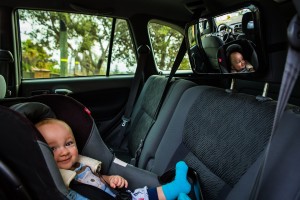 1. Buy a car seat mirror (and use it!)
1. Buy a car seat mirror (and use it!)
If your toddler becomes fussy when rear-facing all of a sudden, it might very well be because she realizes that you’re somewhere very close by but she can’t see you, and that might upset her. It might sound rather obvious, but toddlers seemingly realize obvious things from one moment to the next.
My favorite solution here is to buy a good car seat mirror–and use it! The So Peep mirror is a fantastic one that we use with our kids, and which does a much better job than the Britax mirror we had before it. Set it up with your toddler and show her you can see her, and that she can see you through it. Your tantrums might disappear overnight.
2. Change the seat position
Sometimes toddlers become upset around this age because they simply become bored of being in the same place in the car all the time. Changing the installation of your seat (e.g., moving from the center to an outboard position, or from one outboard position to another) might be just what the doctor ordered for making your toddler view his rear-facing car seat in a whole new (and pleasant) light. If your toddler complains of having the sun in his or her eyes, a rear window sunshade kit might go a long way toward making the view more enjoyable, especially if your toddler won’t wear sun shades.
3. Try restricted toys
Toddlers are at an age where they enjoy new things, but they’re also at an age where they enjoy the comfort of familiar ones. Restricted toys are simply toys that your toddler enjoys but which she doesn’t get to use very often. We’ve found it helpful to have a book handy that’s only available in the car, such as the First 100 Words book. Our daughter spends a good amount of time studying each page and pointing to the objects she can name (and then naming them). It’s surprisingly engrossing.
4. Try familiar toys!
On the other end of the spectrum, some toddlers simply crave things that remind them of home, and if you can bring a treasured blanket, book, or trinket from home to the car seat, this might be enough to make your toddler start enjoying rear-facing car trips again. If you try this strategy, it’s a good idea to discuss which toy your toddler will bring before leaving for a trip, and make his choosing it a special affair. He’ll be more likely to remember its significance once a trip starts, and less likely to fuss.
5. Realize it’s just a phase, or this too shall pass.
This is perhaps the least exciting tip you can hear, but it’s also perhaps the most important. No one really understands what’s going on in a toddler’s mind–not completely, anyway. They’re at an age where they’re learning an awful lot about the world and about themselves, and for many toddlers at that age, they’re simply going to want to do things differently just to see if they can, and just to see what things feel like, and just to see what you do.
This might mean rejecting favorite foods or routines. It might mean saying “no” when they really mean “yes,” or the complete opposite. And sometimes it might simply mean they fuss a lot when rear-facing even though it never used to bother them before. Your job as a parent is to keep your toddler safe; this is a phase that s/he will get through, and that you will get through.
OK, You’ve convinced me. What’s a good convertible for keeping my toddler rear-facing until s/he’s 4 or 5 (e.g., the preschool years)?
There are a lot of great convertibles out there right now that will likely keep your toddler rear-facing until at least 4; I’ve reviewed and recommended many of them here. However, if you’re looking for my absolute favorites, here you go.
I’ve had the privilege of reviewing dozens of ERF-capable seats here, but these are my absolute favorite seats right now:
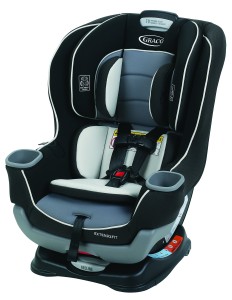 Under $200, I’d strongly recommend the Graco Extend2Fit, Safety 1st Grow and Go EX Air, and Safety 1st Advance EX 65+ Air+. The three seats are very similar, and each is designed to be used from the day your child leaves the hospital until the day s/he weighs 50 pounds. Their height limits mean nearly all kids will make it to 5 rear-facing with them, and lighter children may even make it past 6 or 7!
Under $200, I’d strongly recommend the Graco Extend2Fit, Safety 1st Grow and Go EX Air, and Safety 1st Advance EX 65+ Air+. The three seats are very similar, and each is designed to be used from the day your child leaves the hospital until the day s/he weighs 50 pounds. Their height limits mean nearly all kids will make it to 5 rear-facing with them, and lighter children may even make it past 6 or 7!
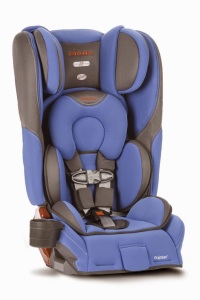 Under $300, my most-recommended seat is the Diono Rainier. If you can find it, the Diono Pacifica is equally safe despite having been discontinued. Again, both seats are almost identical; the main difference lies in the head wings present in the Rainier, which are designed to offer additional side impact protection.
Under $300, my most-recommended seat is the Diono Rainier. If you can find it, the Diono Pacifica is equally safe despite having been discontinued. Again, both seats are almost identical; the main difference lies in the head wings present in the Rainier, which are designed to offer additional side impact protection.
However, the most important part of both seats involves the rear-facing capabilities. Both seats let you rear-face from birth until 50 pounds and have the height limits to make that feasible. They can then be used for quite a while as forward-facing seats, and then, depending on your child, used for some amount of time as booster seats.
 If money’s no object, go with the Clek Fllo or Clek Foonf. Yet again, both seats are very similar, but my top recommendation between the two is the cheaper seat, the Fllo. Combine either seat with the Clek Infant Insert and you can start out rear-facing from birth and keep it up until 50 pounds.
If money’s no object, go with the Clek Fllo or Clek Foonf. Yet again, both seats are very similar, but my top recommendation between the two is the cheaper seat, the Fllo. Combine either seat with the Clek Infant Insert and you can start out rear-facing from birth and keep it up until 50 pounds.
The overall take home points are that young children can be perfectly happy while rear-facing, and that if they aren’t, there are a range of solutions to try. Ultimately, however, if they don’t work and our children are temporarily unhappy, it’s our job as parents to keep rear-facing anyway as long as our seats allow, because it’s by far the safer choice compared to forward-facing.
 If you find my information on best practices in car and car seat safety helpful, you can do your shopping through this Amazon link. Canadians can shop here for Canadian purchases. Have a question or want to discuss best practices? Join us in the forums!
If you find my information on best practices in car and car seat safety helpful, you can do your shopping through this Amazon link. Canadians can shop here for Canadian purchases. Have a question or want to discuss best practices? Join us in the forums!

